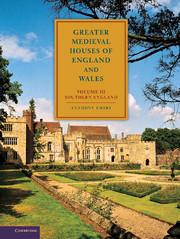Book contents
- Frontmatter
- Contents
- Acknowledgements
- List of abbreviations
- Introduction
- PART I THE THAMES VALLEY
- PART II LONDON AND SOUTH-EAST ENGLAND
- PART III SOUTH-WEST ENGLAND
- Appendix 5 Castles of south-west England: residential additions
- Appendix 6 South-west England: residential licences to crenellate
- Appendix 7 The architectural value of John Leland and the Buck brothers
- List of plates
- List of figures
- Index
- Index of houses in volumes I, II and III
- Frontmatter
- Contents
- Acknowledgements
- List of abbreviations
- Introduction
- PART I THE THAMES VALLEY
- PART II LONDON AND SOUTH-EAST ENGLAND
- PART III SOUTH-WEST ENGLAND
- Appendix 5 Castles of south-west England: residential additions
- Appendix 6 South-west England: residential licences to crenellate
- Appendix 7 The architectural value of John Leland and the Buck brothers
- List of plates
- List of figures
- Index
- Index of houses in volumes I, II and III
Summary
NO new cathedrals were built in England or Wales after 1250, and few monasteries were established between that time and their dissolution 300 years later. The castles of Edward I in North Wales were almost the last fortresses to be erected in this country before the advent of Henry VIII's coastal forts and blockhouses. A considerable number of churches were extended or rebuilt during the later middle ages but they conformed in plan and liturgical function to those of an earlier age. On the other hand, houses had begun to take a recognisable form during the twelfth and thirteenth centuries which reached fulfilment as a prism of society during the following two centuries. They reflected the spread of wealth, the rise of new families, social differentiation, and the organisation and growth of household institutions. Out of the one and a half thousand medieval houses that have survived in England and Wales, nearly 700 are described in these three volumes. They stand as testimony to the first great age of domestic architecture, for that was not an achievement of the Tudors but a development of Plantaganet society between 1300 and 1500. It is these houses that lie at the heart of architectural and related institutional development during the later middle ages.
The crown, the aristocracy, and the gentry of medieval England were the movers and shakers of society. What they did, and how they did it, at national, regional, and local levels affected the government, the economy, the welfare, and the social justice or injustice of the country at all levels of society.
- Type
- Chapter
- Information
- Publisher: Cambridge University PressPrint publication year: 2006

